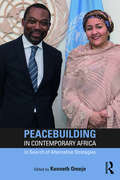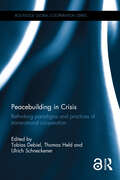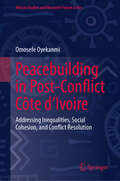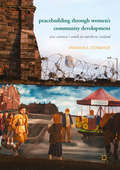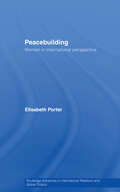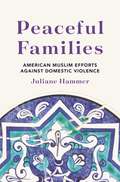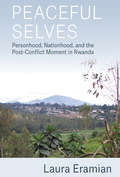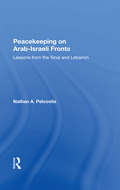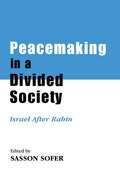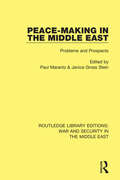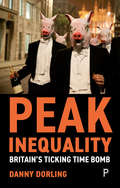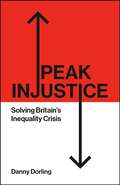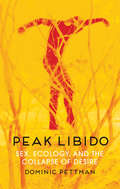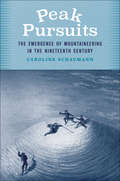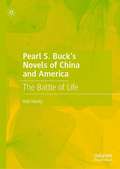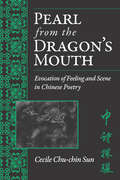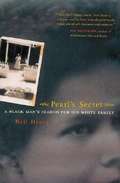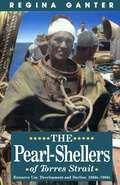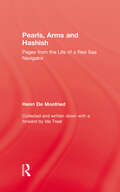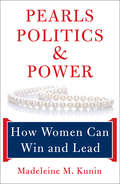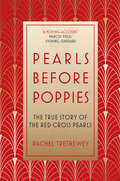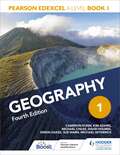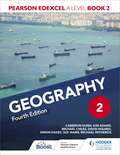- Table View
- List View
Peacebuilding in Contemporary Africa: In Search of Alternative Strategies (Routledge Studies in African Development)
by Kenneth OmejePeacebuilding in Contemporary Africa explores the challenges and opportunities faced by countries and societies transitioning from armed conflicts to peace in contemporary Africa. It evaluates the effectiveness, outcomes and failures of existing peacebuilding initiatives implemented by stakeholders, and proposes new strategies and approaches to facilitate the transition. The book investigates both micro- and macro-level conflicts in various parts of Africa, as well as the efforts made to resolve them and build peace. The book pays particular attention to grassroots-based micro-level conflicts often disregarded in peacebuilding literature, which tends to focus on macro-level, neo-liberal state reconstruction and peacebuilding efforts. The book adopts an evidence-based, policy-relevant approach to peacebuilding in Africa. The various chapter contributors offer a lucid analysis and critique of some of the prevailing paradigms and strategies of peacebuilding practiced in Africa. Together, the authors recommend innovative strategies to mobilise and coordinate governance institutions and partnerships at all levels (international, regional, national, and local) to prevent conflict escalation in volatile states and advance the rebuilding of violence-affected states and communities. Peacebuilding in Contemporary Africa provides a much-needed perspective from African scholars, and will be of interest to students, researchers, policy makers and practitioners with an interest in promoting legitimate policy interventions and sustainable peace in Africa.
Peacebuilding in Crisis: Rethinking Paradigms and Practices of Transnational Cooperation (Routledge Global Cooperation Series)
by Thomas Held Tobias Debiel Ulrich SchneckenerThe 1990s saw a constant increase in international peace missions, predominantly led by the United Nations, whose mandates were more and more extended to implement societal and political transformations in post-conflict societies. However, in many cases these missions did not meet the high expectations and did not acquire a sufficient legitimacy on the local level. Written by leading experts in the field, this edited volume brings together ‘liberal’ and ‘post-liberal’ approaches to peacebuilding. Besides challenging dominant peacebuilding paradigms, the book scrutinizes how far key concepts of post-liberal peacebuilding offer sound categories and new perspectives to reframe peacebuilding research. It thus moves beyond the ‘liberal’–‘post-liberal’ divide and systematically integrates further perspectives, paving the way for a new era in peacebuilding research which is theory-guided, but also substantiated in the empirical analysis of peacebuilding practices.This book will be essential reading for postgraduate students and scholar-practitioners working in the field of peacebuilding. By embedding the subject area into different research perspectives, the book will also be relevant for scholars who come from related backgrounds, such as democracy promotion, transitional justice, statebuilding, conflict and development research and international relations in general.
Peacebuilding in Post-Conflict Côte d'Ivoire: Addressing Inequalities, Social Cohesion, and Conflict Resolution (African Studies and Research Forum Series)
by Omosefe OyekanmiThis book examines the peacebuilding efforts in Côte d’Ivoire after the 2002–2011 civil war, highlighting the complex dynamics of conflict resolution and social cohesion in fragile states. It analyzes historical, political, and socio-economic contexts, and provides practical insights to address inequalities and strengthen sustainable peace in Africa and beyond. The book further scrutinizes UN-supported programs and various conflict resolution strategies, including mediation, negotiation, arbitration, and military intervention, as they are applied in Côte d’Ivoire and other African contexts. Key chapters explore the root causes of Ivorian conflicts, such as economic disparities, ethnic tensions, and political power struggles, and discuss the challenges of disarmament and economic instability. The book highlights the importance of community dialogue, reconciliation, and local leadership, especially women, to advance harmony and address social inequalities. It critically analyzes external influences and evaluates international and regional peacebuilding strategies. The book will appeal to students, scholars, and researchers of political science, international relations, African studies, security studies, and the social sciences, as well as policy-makers interested in a better understanding of peacebuilding in Côte d’Ivoire, Africa, and beyond.
Peacebuilding through Women’s Community Development
by Amanda E. DonahoeThis book explores the gendered history of the Troubles, the rise of the Northern Ireland Women's Coalition, and the role of community development as a new field in Northern Ireland. Nearly twenty years after the Belfast or Good Friday Agreement that ended the Troubles in Northern Ireland, tensions persist and society is still deeply divided. The book addresses the ways in which women navigate these tensions and contribute to peacebuilding through community development, described dismissively by many in Northern Ireland as the work of "wee women. " Women navigate this gendered space to build peace strategically through "Wee Women's Work. " The author focuses in particular on the Women's Sector and draws on feminist theory to examine the distinction between formal and informal politics.
Peacebuilding: Women in International Perspective (Routledge Advances in International Relations and Global Politics #Vol. 60)
by Elisabeth PorterThis book clarifies some key ideas and practices underlying peacebuilding; understood broadly as formal and informal peace processes that occur during pre-conflict, conflict and post-conflict transformation. Applicable to all peacebuilders, Elisabeth Porter highlights positive examples of women’s peacebuilding in comparative international contexts. She critically interrogates accepted and entrenched dualisms that prevent meaningful reconciliation, while also examining the harm of othering and the importance of recognition, inclusion and tolerance. Drawing on feminist ethics, the book develops a politics of compassion that defends justice, equality and rights and the need to restore victims’ dignity. Complex issues of memory, truth, silence and redress are explored while new ideas on reconciliation and embracing difference emerge. Many ideas challenge orthodox understandings of peace. The arguments developed here demonstrate how peacebuilding can be understood more broadly than current United Nations and orthodox usages so that women’s activities in conflict and transitional societies can be valued as participating in building sustainable peace with justice. Theoretically integrating peace and conflict studies, international relations, political theory and feminist ethics, this book focuses on the lessons to be learned from best practices of peacebuilding situated around the UN Security Council Resolution 1325 on Women, Peace and Security. Peacebuilding will be of particular interest to peace practitioners and to students and researchers of peace and conflict studies, international relations and gender politics.
Peaceful Families: American Muslim Efforts against Domestic Violence
by Professor Juliane HammerAn in-depth look at how Muslim American organizations address domestic violence within their communitiesIn Peaceful Families, Juliane Hammer chronicles and examines the efforts, stories, arguments, and strategies of individuals and organizations doing Muslim anti–domestic violence work in the United States. Looking at connections among ethical practices, gender norms, and religious interpretation, Hammer demonstrates how Muslim advocates mobilize a rich religious tradition in community efforts against domestic violence, and identify religion and culture as resources or roadblocks to prevent harm and to restore family peace.Drawing on her interviews with Muslim advocates, service providers, and religious leaders, Hammer paints a vivid picture of the challenges such advocacy work encounters. The insecurities of American Muslim communities facing intolerance and Islamophobia lead to additional challenges in acknowledging and confronting problems of spousal abuse, and Hammer reveals how Muslim anti–domestic violence workers combine the methods of the mainstream secular anti–domestic violence movement with Muslim perspectives and interpretations. Identifying a range of Muslim anti–domestic violence approaches, Hammer argues that at certain times and in certain situations it may be imperative to combat domestic abuse by endorsing notions of “protective patriarchy”—even though service providers may hold feminist views critical of patriarchal assumptions. Hammer links Muslim advocacy efforts to the larger domestic violence crisis in the United States, and shows how, through extensive family and community networks, advocates participate in and further debates about family, gender, and marriage in global Muslim communities.Highlighting the place of Islam as an American religion, Peaceful Families delves into the efforts made by Muslim Americans against domestic violence and the ways this refashions the society at large.
Peaceful Islamist Mobilization in the Muslim World
by Julie Chernov HwangIn "Peaceful Islamist Mobilization in the Muslim World: What Went Right, "Julie Chernov Hwang presents a compelling and innovative new theory and framework for examining the variation in Islamist mobilization strategies in Muslim Asia and the Middle East.
Peaceful Selves: Personhood, Nationhood, and the Post-Conflict Moment in Rwanda
by Laura EramianThis ethnography of personhood in post-genocide Rwanda investigates how residents of a small town grapple with what kinds of persons they ought to become in the wake of violence. Based on fieldwork carried out over the course of a decade, it uncovers how conflicting moral demands emerge from the 1994 genocide, from cultural contradictions around "good" personhood, and from both state and popular visions for the future. What emerges is a profound dissonance in town residents' selfhood. While they strive to be agents of change who can catalyze a new era of modern Rwandan nationhood, they are also devastated by the genocide and struggle to recover a sense of selfhood and belonging in the absence of kin, friends, and neighbors. In drawing out the contradictions at the heart of self-making and social life in contemporary Rwanda, this book asserts a novel argument about the ordinary lives caught in global post-conflict imperatives to remember and to forget, to mourn and to prosper.
Peacekeeping On Arab-Israeli Fronts: Lessons From The Sinai And Lebanon
by Nathan A PelcovitsSince 1948, the United Nations has sponsored virtually every third party peacekeeping mission on Arab· Israeli fronts. Three recent events, however, have been responsible for significantly altering the pattern of peacekeeping in the region: the Camp David accords, which, because they were opposed in the U.N. by the Soviet Union and most Arab nations, prevented U.N. sponsorship of a Sinai peacekeeping force; the June 1982 Israeli invasion of Lebanon, during which the U.N. Interim Force was made to look ineffectual; and the Sabra-Shatila massacres in South Beirut three months later, which prompted the deployment of a multinational peacekeeping force. Dr.Pelcovits analyzes these events to answer the questions they raise about peacekeeping in the Middle East: What advantages are afforded by U.N. peacekeepers compared with non-U.N. missions? What net benefits are derived from American participation in a non-U.N. multinational operation? And how do they compare to the classic U.N. peacekeeping rationale of insulating disputed areas from super power confrontation? Finally, what determines the success of such operations-geopolitical circumstance or institutional affiliation?
Peacemaking in a Divided Society: Israel After Rabin (Israeli History, Politics and Society #Vol. 12)
by Sasson SoferThis is an interdisciplinary study of Israeli society in one of the defining moments in the history of Israel. The contributors discuss the critical aspects of the political order, economics, the military, the role of the media and legal reform that are shaping a new Israel.
Peacemaking in the Middle East: Problems and Prospects (Routledge Library Editions: War and Security in the Middle East)
by Janice Gross Stein Paul MarantzThis book, first published in 1985, examines the whole problem of peacemaking in the Arab-Israel conflict. It considers the different countries involved, the changing positions they have adopted over time and the range of opinion within each country. It looks at the role of the superpowers and shows how their vacillations and their viewing of the conflict in simple terms as part of the global superpower rivalry have been unfortunate. It examines how a typical uncommitted medium power – Canada – can contribute to peace in very many ways though it may not achieve a breakthrough.
Peak Inequality: Britain's Ticking Time Bomb
by Danny DorlingInequality is the key political issue of our time. Danny Dorling wrote his seminal work Injustice: Why social inequality persists in 2010, and as an early proponent of rapidly reducing economic inequalities, he is now much sought-after as one of the foremost contributors to the debates surrounding it. Here Dorling brings together brand new material alongside a carefully curated selection of his most recent writing on inequality from publications as wide ranging as the Daily Telegraph, the Guardian, New Statesman, Financial Times and the China People’s Daily. Covering key inequality issues including politics, housing, education and health, he explores whether we have now reached ‘peak inequality’. He concludes, crucially, by predicting what the future holds for Britain, as attempts are made to defuse the ticking time bomb while we simultaneously try to negotiate Brexit and react to the wider international situation of a world of people demanding to become more equal.
Peak Injustice: Solving Britain’s Inequality Crisis
by Danny DorlingBy 2024 a majority of parents in the UK with three or more children were going hungry to feed their families. Children in the UK are becoming shorter and childhood mortality has been rising. What part does living with high inequality play in understanding how we have got to the point of peak injustice, when surely the situation cannot become worse? Although 2018 was a year of peak income and wealth inequality in the UK, absolute deprivation has continued to grow since then, especially after the pandemic. Peak Injustice follows up the best-selling Peak Inequality (2018), offering a carefully curated selection of Danny Dorling’s latest published writing with brand new content looking to the future, including challenges for a new government in 2024/25, the impact of Jeremy Corbyn’s legacy, and the implications of Keir Starmer’s many blind spots. An essential addition to readers’ Dorling collections.
Peak Libido: Sex, Ecology, and the Collapse of Desire
by Dominic PettmanWhat is the carbon footprint of your libido? In this highly original book, Dominic Pettman examines the mutual influence and impact of human desire and ecological crisis. His account is premised on a simple but startling observation: the decline of libido among the world’s population, the loss of the human sex drive, closely tracks the destruction of environments worldwide. The advent of the Anthropocene leads to the decline of eros, the weakening of the link between sexual pleasure and human reproduction, and thus, potentially, to human extinction. Our capacity to care for one another in any meaningful way is being replaced by a restless, technologically-enhanced zombie drive. The environmental crisis of our time is also, and simultaneously, a crisis of human reproduction and of interpersonal intimacy. What Freud called ‘libidinal economy’ has morphed into libidinal ecology. Drawing on the work of a wide range of thinkers from Georges Bataille to Donna Haraway, Pettman explores the implications of peak libido, linking this development to the new cultural interest in eco-sexuality, polyamory, and other cases of the ‘greening of the libido’. Peak Libido is a forceful reminder that our hearts and loins are primarily ecological organs, beholden to their wider environments, and, as such, they share the same fate.
Peak Pursuits: The Emergence of Mountaineering in the Nineteenth Century
by Caroline SchaumannAn interdisciplinary cultural history of exploration and mountaineering in the nineteenth century European forays to mountain summits began in the late eighteenth and early nineteenth centuries with the search for plants and minerals and the study of geology and glaciers. Yet scientists were soon captivated by the enterprise of climbing itself, enthralled with the views and the prospect of &“conquering&” alpine summits. Inspired by Romantic notions of nature, early mountaineers idealized their endeavors as sublime experiences, all the while deliberately measuring what they saw. As increased leisure time and advances in infrastructure and equipment opened up once formidable mountain regions to those seeking adventure and sport, new models of masculinity emerged that were fraught with tensions. This book examines how written and artistic depictions of nineteenth-century exploration and mountaineering in the Andes, the Alps, and the Sierra Nevada shaped cultural understandings of nature and wilderness in the Anthropocene.
Pearl S. Buck’s Novels of China and America: The Battle of Life
by Rob HardyThis book, the first single-authored book-length study of Buck’s fiction for over twenty years, shows how Buck’s thought developed through the medium of her fiction - from her early turbulent years in China to her last lonely days in the United States, with chapters examining her loss of faith in Christianity, her reflections on Chinese life during and after the breakdown of Old China, her voluminous reading, her confrontation with the horrors of American racism and sexism after her return to the United States, and her final metaphorical search for home as she approached death. The book argues that Buck, the first American woman to win both the Pulitzer and Nobel prizes for literature, was a heroic forerunner of those who, while occupying a place in the world, never feel fully at home there; in Buck’s case because her Chinese identity throughout her life struggled with her American. For this reason Pearl S. Buck’s fiction deserves to be considered alongside that of writers such as Anchee Min, Maxine Hong Kingston and Amy Tan. The book’s central claim is that Buck is a major novelist, capable of speaking to the distress of our times, richly deserving the honor she has received in China, and deserving greater recognition in the United States.
Pearl from the Dragon’s Mouth: Evocation of Scene and Feeling in Chinese Poetry (Michigan Monographs In Chinese Studies #67)
by Cecile C. SunThe interplay between the external world (ching) and the poet’s inner world (ch’ing) lies at the heart of Chinese poetry, and understanding the interaction of the two is crucial to understanding this work from within its own tradition. Closely coordinating her discussions of poetry and criticism so that practice and theory become mutually enriching and illuminating, Sun offers sensitive and original readings of poems and a wealth of insights into Chinese poetics.
Pearl's Secret: A Black Man's Search for His White Family
by Neil HenryPearl's Secret is a remarkable autobiography and family story that combines elements of history, investigative reporting, and personal narrative in a riveting, true-to-life mystery. In it, Neil Henry--a black professor of journalism and former award-winning correspondent for the Washington Post--sets out to piece together the murky details of his family's past. His search for the white branch of his family becomes a deeply personal odyssey, one in which Henry deploys all of his journalistic skills to uncover the paper trail that leads to blood relations who have lived for more than a century on the opposite side of the color line. At the same time Henry gives a powerful and vivid account of his black family's rise to success over the twentieth century. Throughout the course of this gripping story the author reflects on the part that racism and racial ignorance have played in his daily life--from his boyhood in largely white Seattle to his current role as a parent and educator in California.
Pearl-Shellers Of Torres Strait: Resource Use, Development and Decline, 1860s–1960s
by Regina GanterIn an ethnically stratified work force, Japanese, South Sea Islander, Torres Strait Islander and Aboriginal divers brought up from the sea floor the shell that produced mother-of-pearl, and sometimes pearls. Many men died at this dangerous work. This was an industry that could have given the indigenous peoples of Torres Strait an occupation that preserved their identity and independence. Yet in spite of a co-operative lugger scheme that operated fairly successfully in the early twentieth century, a real independence was not achieved. And a resource that could have been conserved by small-scale indigenous harvesting was depleted time and again by the colonial practices of resource-raiding and mass extraction. Regina Ganter charts the progress of pearl-shelling from its heyday through its several crises resulting from overfishing to its present cautious management. The book is greatly enhanced by the oral testimony of divers and boat-owners.
Pearls Arms & Hashish
by MonfriedFirst published in 2010. Routledge is an imprint of Taylor & Francis, an informa company.
Pearls Politics & Power
by Madeleine M. KuninPearls, Politics, and Power is a call to action for new political engagement and leadership from the women of America. Informed by conversations with elected women leaders from all levels, former three-term Vermont Governor and Ambassador to Switzerland Madeleine M. Kunin asks: What difference do women make? What is the worst part of politics, and what is the best part? What inspired these women to run, and how did they prepare themselves for public life? How did they raise money, protect their families' privacy, deal with criticism and attack ads, and work with the good old boys?Kunin's core message is that America needs an infusion of new leadership to better address the major problems of our time. To see how women can achieve that goal, she combines her personal experience in politics; the lessons of past women's movements; the stories of young women today who have new ideas about their role in society; and interviews with a wide range of women in positions of power, looking for clues to their leadership, as well as the effects of gender stereotyping. She interviews Senator Hillary Rodham Clinton, analyzes her campaign, and addresses the question: "Is the country ready?" Other interviewees include U. S. Representatives Loretta Sanchez, Linda Sanchez, Deborah Pryce, and Tammy Baldwin, and U. S. Senators Susan Collins, Amy Klobuchar, and Carol Moseley Braun, and Governors Kathleen Sibelius and Janet Napolitano. The next generation of women will be inspired to lead by seeing women like Nancy Pelosi wielding the gavel, and seeing themselves reflected in the portraits in statehouses, courthouses, corporate and university boardrooms, and the White House. Pearls, Politics, and Power will help ensure that this inspiration is not soured or deflected, but channeled into successful candidacies by America's leaders of tomorrow. What will it take for women to assume their rightful places in the political corridors of power?
Pearls before Poppies: The True Story of the Red Cross Pearls
by Rachel TretheweyIn February 1918, when the First World War was still being bitterly fought, prominent society member Lady Northcliffe conceived an idea to help raise funds for the British Red Cross. Using her husband’s newspapers, The Times and the Daily Mail, she ran a campaign to collect enough pearls to create a necklace, intending to raffle the piece to raise money. The campaign captured the public’s imagination. Over the next nine months nearly 4,000 pearls poured in from around the world. Pearls were donated in tribute to lost brothers, husbands and sons, and groups of women came together to contribute one pearl on behalf of their communities. Those donated ranged from priceless heirlooms –one had survived the sinking of the Titanic – to imperfect yet treasured trinkets. Working with Christie’s and the International Fundraising Committee of the British Red Cross, author Rachel Trethewey expertly weaves the touching story of a generation of women who gave what they had to aid the war effort and commemorate their losses.
Pearson Edexcel A Level Geography Book 1 Fourth Edition
by Sue Warn Cameron Dunn Simon Oakes David Holmes Michael Witherick Kim Adams Michael ChilesCramming all new-case studies, new geographic data and reams of new questions, this new edition Pearson Edexcel A-level Geography student book will capture imaginations as it travels around the globe.This new book will help your students develop the geographical skills and knowledge they need to succeed. It has been written by our expert author team and structured to provide support for learners of all abilities. The book includes:· Activities and regular review questions to reinforce geographical knowledge and build up core geographical skills· Clear explanations to help students to grapple with tricky geographical concepts and grasp links between topics· Case studies from around the world to vividly demonstrate geographical theory in action· Exciting fieldwork projects that meet the fieldwork and investigation requirementsThis student book is supported by digital resources on our new digital platform Boost, providing a seamless online and offline teaching experience.
Pearson Edexcel A Level Geography Book 1 Fourth Edition
by Sue Warn Cameron Dunn Simon Oakes David Holmes Michael Witherick Kim Adams Michael ChilesCramming all new-case studies, new geographic data and reams of new questions, this new edition Pearson Edexcel A-level Geography student book will capture imaginations as it travels around the globe.This new book will help your students develop the geographical skills and knowledge they need to succeed. It has been written by our expert author team and structured to provide support for learners of all abilities. The book includes:· Activities and regular review questions to reinforce geographical knowledge and build up core geographical skills· Clear explanations to help students to grapple with tricky geographical concepts and grasp links between topics· Case studies from around the world to vividly demonstrate geographical theory in action· Exciting fieldwork projects that meet the fieldwork and investigation requirementsThis student book is supported by digital resources on our new digital platform Boost, providing a seamless online and offline teaching experience.
Pearson Edexcel A Level Geography Book 2 Fourth Edition
by Sue Warn Cameron Dunn Simon Oakes David Holmes Michael Witherick Kim Adams Michael ChilesCramming all new-case studies, new geographic data and reams of new questions, this new Pearson Edexcel A-level Geography student book will capture imaginations as it travels around the globe.This new book will help your students develop the geographical skills and knowledge they need to succeed. It has been written by our expert author team and structured to provide support for learners of all abilities. The book includes:· Activities and regular review questions to reinforce geographical knowledge and build up core geographical skills· Clear explanations to help students to grapple with tricky geographical concepts and grasp links between topics· Case studies from around the world to vividly demonstrate geographical theory in action· Exciting fieldwork projects that meet the fieldwork and investigation requirementsThis student book is supported by digital resources on our new digital platform Boost, providing a seamless online and offline teaching experience.
